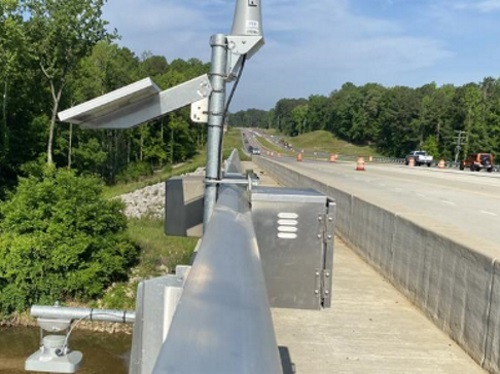The North Carolina Department of Transportation recently activated a new flood-warning system that relies on a network of 400 river and stream gauges to help analyze, map, and communicate in real-time any flood risks to roads, bridges, and culverts.
[Above photo by NCDOT]
This critical information goes to NCDOT maintenance staff responding to flooded roads and washed-out culverts yet also benefits local emergency management officials and the public accessing the department’s DriveNC.gov website for timely weather-related closures.
“This state-of-the-art warning system our department has created will help us be better prepared for the next major storm,” explained Eric Boyette, NCDOT secretary, in a statement. “Even though we’ve had some quiet hurricane seasons recently, we cannot let our guard down.”
[Editor’s note: The latest episode of the American Association of State Highway and Transportation Officials “2 Minute State DOT Update” video series profiles NCDOT’s workforce diversity efforts.]
The damage to North Carolina’s road network caused by Hurricane Florence in 2018 spurred the development of this new flood-warning system, NCDOT noted.
Following Hurricane Florence, the state legislature gave NCDOT a $2 million grant to develop sophisticated software and install more flood gauges. The new system, however, mostly taps into existing gauges operated by other agencies, such as the North Carolina Emergency Management and the U.S. Geological Survey, and includes an interactive online dashboard and flood mapping based on three-dimensional ground surveys.

One part of the new early flood-warning system covers almost 3,000 miles of state-maintained roads, mostly east of Interstate 95 – allowing NCDOT to monitor flood conditions for some 15,000 bridges and culverts statewide.
The agency’s Hydraulics Unit has been fine-tuning the system and training staff on it with smaller storms over the past year.
In addition, the NCDOT has formed a recent partnership with the University of North Carolina at Chapel Hill’s Renaissance Computing Institute and the U.S. Department of Homeland Security’s Coastal Resilience Center of Excellence to receive forecast modeling data on how storm surge may affect the state’s road network in coastal areas.
 States
States
NCDOT Staff Participate in ‘Explosive’ Technical Training
December 19, 2025 States
States

